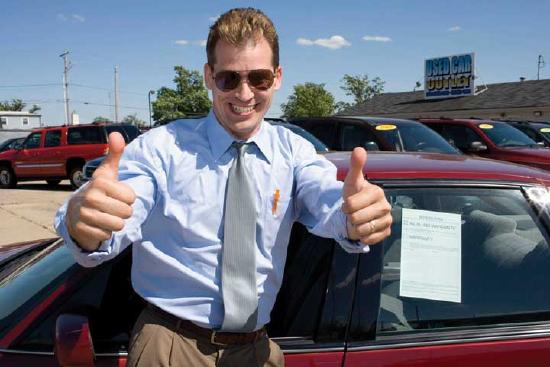10.8.3: Adverse Selection
- Last updated
- Save as PDF
- Page ID
- 59567

- Anonymous
- LibreTexts
Learning Objectives
- What problems do asymmetric information and, more specifically, adverse selection cause and how can they be mitigated?
Adverse selection is precontractual asymmetric information. It occurs because the riskiest potential borrowers and insureds have the greatest incentive to obtain a loan or insurance.
The classic case of adverse selection, the one that brought the phenomenon backClassical economists like Adam Smith recognized adverse selection and asymmetric information more generally, but they did not label or stress the concepts.to the attention of economists in 1970, is the market for “lemons,” which is to say, breakdown-prone automobiles. The lemons story, with appropriate changes, applies to everything from horses to bonds, to lemons (the fruit), to construction services. That is because the lemons story is a simple but powerful one. People who offer lemons for sale know that their cars stink. Most people looking to buy cars, though, can’t tell that a car is prone to breakdown. They might kick the tires, take it for a short spin, look under the hood, etc., all without discovering the truth. The seller has superior information and indeed has an incentive to increase the asymmetry by putting a Band-Aid over any obvious problems. (He might, for example, warm the car up thoroughly before showing it, put top-quality gasoline in the tank, clean up the oil spots in the driveway, and so forth.) He may even explain that the car was owned by his poor deceased grandmother, who used it only to drive to church on Sundays (for services) and Wednesdays (for bingo), and that she took meticulous care of it. The hapless buyer, the story goes, offers the average price for used cars of the particular make, model, year, and mileage for sale. The seller happily (and greedily if you want to be moralistic about it) accepts. A day, week, month, or year later, the buyers learns that he has overpaid, that the automobile he purchased is a lemon. He complains to his relatives, friends, and neighbors, many of whom tell similar horror stories. A consensus emerges that all used cars are lemons.
Of course, some used cars are actually “peaches,” very reliable means of personal transportation. The problem is that owners of peaches can’t credibly inform buyers of the car’s quality. Oh, she can say, truthfully, that the car was owned by her poor deceased grandmother who used it only to drive to church on Sundays (for services) and Wednesdays (for bingo) and that she took meticulous care of it. But that sounds a lot like what the owner of the lemon says too. (In fact, we just copied and pasted it from above!) So the asymmetric information remains and the hapless buyer offers the average price for used cars of the particular make, model, year, and mileage for sale. (Another copy and paste job!) But this time the seller, instead of accepting the offer, gets offended and storms off (or at least declines). So the buyer’s relatives, friends, and neighbors are half right—not all the used cars for sale are lemons, but those that are bought are!
Now appears our hero, the used car dealer, who is literally a dealer in the same sense a securities dealer is: he buys from sellers at one (bid) price and then sells to buyers at a higher (ask) price. He earns his profits or spread by facilitating the market process by reducing asymmetric information. Relative to the common person, he is an expert at assessing the true value of used automobiles. (Or his operation is large enough that he can hire such people and afford to pay them. See the transaction costs section above.) So he pays more for peaches than lemons (ceteris paribus, of course) and the used car market begins to function at a much higher level of efficiency. Why is it, then, that the stereotype of the used car salesman is not very complimentary? That the guy in Figure 8.4 "Shady used car salesman" seems more typical than the guy in Figure 8.5?
 ©
2010 Jupiterimages Corporation
©
2010 Jupiterimages Corporation

© 2010 Jupiterimages Corporation
Several explanations come to mind. The market for used car dealers may be too competitive, leading to many failures, which gives dealers incentives to engage in rent seeking (ripping off customers) and disincentives to establish long-term relationships. Or the market may not be competitive enough, perhaps due to high barriers to entry. Because sellers and buyers have few choices, dealers find that they can engage in sharp business practiceswww.m-w.com/dictionary/sharp and still attract customers as long as they remain better than the alternative, the nonfacilitated market. I think the latter more likely because in recent years, many used car salesmen have cleaned up their acts in the face of national competition from the likes of AutoNation and similar companies.en.Wikipedia.org/wiki/AutoNation Moreover, CarFax.com and similar companies have reduced asymmetric information by tracking vehicle damage using each car’s unique vehicle identification number (VIN), making it easier for buyers to reduce asymmetric information without the aid of a dealer.
What does this have to do with the financial system? Plenty, as it turns out. As noted above, adverse selection applies to a wide variety of markets and products, including financial ones. Let’s suppose that, like our friend Mr. Knapp above, you have some money to lend and the response to your advertisement is overwhelming. Many borrowers are in the market. Information is asymmetric—you can’t really tell who the safest borrowers are. So you decide to ration the credit as if it were apples, by lowering the price you are willing to give for their bonds (raising the interest rate on the loan). Big mistake! As the interest rate increases (the sum that the borrower/securities seller will accept for his IOU decreases), the best borrowers drop out of the bidding. After all, they know that their projects are safe, that they are the equivalent of an automotive peach. People with riskier business projects continue bidding until they too find the cost of borrowing too high and bow out, leaving you to lend to some knave, to some human lemon, at a very high rate of interest. That, our friend, is adverse selection.
Adverse selection also afflicts the market for insurance. Safe risks are not willing to pay much for insurance because they know that the likelihood that they will suffer a loss and make a claim is low. Risky people and companies, by contrast, will pay very high rates for insurance because they know that they will probably suffer a loss. Anyone offering insurance on the basis of premium alone will end up with the stinky end of the stick, just as the lender who rations on price alone will.
Like used car dealers, financial facilitators and intermediaries seek to profit by reducing adverse selection. They do so by specializing in discerning good from bad credit and insurance risks. Their main weapon here is called screening and it’s what all those forms and questions are about when you apply for a loan or insurance policy. Potential lenders want to know if you pay your bills on time, if your income minus expenses is large and stable enough to service the loan, if you have any collateral that might protect them from loss, and the like. Potential insurers want to know if you have filed many insurance claims in the past because that may indicate that you are clumsy; not very careful with your possessions; or worse, a shyster who makes a living filing insurance claims. They also want to know more about the insured property so they don’t insure it for too much, a sure inducement to start a fire or cause an accident. They also need to figure out how much risk is involved, how likely a certain type of car is to be totaled if involved in an accident,www.edmunds.com/ownership/safety/articles/43804/article.html the probability of a wood-frame house burning to the ground in a given area,www.usfa.dhs.gov/statistics/national/residential.shtm the chance of a Rolex watch being stolen, and so forth.
Stop and Think Box
Credit-protection insurance policies promise to make payments to people who find themselves unemployed or incapacitated. Whenever solicited to buy such insurance, I (Wright) always ask how the insurer overcomes adverse selection because there are never any applications or premium schedules, just one fixed rate. Why do I care?
I care because I’m a peach of a person. I know that if I lived a more dangerous lifestyle or was employed in a more volatile industry that I’d snap the policy right up. Given my current situation, however, I don’t think it very likely that I will become unemployed or incapacitated, so I don’t feel much urgency to buy such a policy at the same rate as some guy or gal who’s about to go skydiving instead of going to work. I don’t want to subsidize them or to deal with a company that doesn’t know the first thing about insurance.
Financial intermediaries are not perfect screeners. They often make mistakes. Insurers like State Farm, for example, underestimated the likelihood of a massive storm like Katrina striking the Gulf Coast. And subprime mortgage lenders, companies that lend to risky borrowers on the collateral of their homes, grossly miscalculated the likelihood that their borrowers would default. Competition between lenders and insurers induces them to lower their screening standards to make the sale. (In a famous cartoon in the Wall Street Journal, a clearly nonplussed father asks a concerned mom how their son’s imaginary friend got preapproved for a credit card.) At some point, though, adverse selection always rears its ugly head, forcing lenders and insurance providers to improve their screening procedures and tighten their standards once again. And, on average, they do much better than you or I acting alone could do.
Another way of reducing adverse selection is the private production and sale of information. Before the 1970s, companies like Standard and Poor’s, Bests, Duff and Phelps, Fitch’s, and Moody’s compiled and analyzed data on companies, rated the riskiness of their bonds, and then sold that information to investors in huge books. The free-rider problem, though, killed off that business model. Specifically, the advent of cheap photocopying induced people to buy the books, photocopy them, and sell them at a fraction of the price that the bond-rating agencies could charge. (The free riders had to pay only the variable costs of publication; the rating agencies had to pay the large fixed costs of compiling and analyzing the data.) So in the mid-1970s, the bond-rating agencies began to give their ratings away to investors and instead charged bond issuers for the privilege of being rated. The new model greatly decreased the effectiveness of the ratings because the new arrangement quickly led to rating inflation similar to grade inflation. (Pleasure flows with the cash. Instead of pleasing investors, the agencies started to please the issuers.) After every major financial crisis, including the subprime mortgage mess of 2007, academics and former government regulators lambaste credit-rating agencies for their poor performance relative to markets and point out the incentive flaws built into their business model. Thus far, little has changed, but encrypted databases might allow a return to the investor-pay model. But then another form of free riding would arise as investors who did not subscribe to the database would observe and mimic the trades of those investors known to have subscriptions. Due to the free-rider problem inherent in markets, banks and other financial intermediaries have incentives to create private information about borrowers and people who are insured. This helps to explain why they trump bond and stock markets.
Adverse selection can also be reduced by contracting with groups instead of individuals. Insurers, for example, offer group health and life insurance policies to employers because doing so reduces adverse selection. Chronically or terminally ill people usually do not seek employment, so the riskiest part of the population is excluded from the insurance pool. Moreover, it is easier for insurers to predict how many claims a group of people will submit over some period of time than to predict the probability that a specific individual will make a claim. Life expectancy tables,www.ssa.gov/oact/STATS/table4c6.html for example, accurately predict how many people will die in a given year but not which particular individuals will perish.
Governments can no more legislate away adverse selection than they can end scarcity by decree. They can, however, give markets and intermediaries a helping hand. In the United States, for example, the Securities and Exchange Commission (SEC) tries to ensure that corporations provide market participants with accurate and timely information about themselves, reducing the information asymmetry between themselves and potential bond- and stockholders.www.sec.gov Like sellers of lemons, however, bad companies often outfox the SEC (and similar regulators in other countries) and investors, especially when said investors place too much confidence in government regulators. In 2001, for example, a high-flying energy trading company named Enron suddenly encountered insurmountable financial difficulties and was forced to file for bankruptcy, the largest in American history at that time. Few saw Enron’s implosion coming because the company hid its debt and losses in a maze of offshore shell companies and other accounting smokescreens. Some dumbfounded investors hadn’t bothered watching the energy giant because they believed the government was doing it for them. It wasn’t.
KEY TAKEAWAYS
- Asymmetric information decreases the efficiency of financial markets, thereby reducing the flow of funds to entrepreneurs and injuring the real economy.
- Adverse selection is precontractual asymmetric information.
- It can be mitigated by screening out high-risk members of the applicant pool.
- Financial market facilitators can also become expert specialists and attain minimum efficient scale, but financial markets are hampered by the free-rider problem.
- In short, few firms find it profitable to produce information because it is easy for others to copy and profit from it. Banks and other intermediaries, by contrast, create proprietary information about their borrowers and people they insure.

